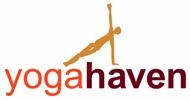Following is the first student question we have received. Please feel free to email a general question or a question for a specific teacher regarding yoga to betsy@yogahaven.com.
"Hi, I have been practicing Ashtanga Yoga for 1 year and I love it...but I have developed a couple injuries along the way. Can you give me any idea why I might be having shoulder and neck issues?"
It’s so important for yoga practitioners to recognize signs of strain or injury as early as possible. What starts out as a nagging discomfort somewhere in your body could be a warning signal. For newer practitioners, it can sometimes take a while to become fully aware that something isn’t right. As you gain experience, however, you’ll begin to develop an inner knowledge and connection to your body that allows you to recognize more quickly when something is wrong. Then it takes humility, honesty, and openness to acknowledge that something might be going awry with your practice.
 |
| incorrect chaturanga with shoulders dropping |
 |
| torso and pelvis placement on the blocks correct chaturanga |
I’ve had many students over the years who have complained of shoulder and neck pain. One reason for this is that in the practice of Ashtanga and other forms of yoga, there are some opportunities for repetitive upper body stress injuries from all of the Chaturanga Dandasana and Urdhva Mukha Svanasana (up-dog) in the sequence. Chaturanga Dandasana is extremely difficult, because it requires both great strength and tremendous coordination of multiple muscle groups. When lowering down into the pose from down dog or plank, the journey from straight arm to bent arm puts a load on the shoulder joint that can strain the tendons, ligaments, bursa, and other connective tissue. Weakness in the rhomboids, middle trapizius, rear deltoids, terres minor, and tricep muscles, (upper back and back of arm), combined with tightness in the pectorals, front deltoids, subscapularus, and latisamus dorse (chest and front of arm), all combine to pull the head of the humerous (the top of the upper arm bone), forward, closing the chest and straining the front and rear of the shoulder joint. If you watch people doing the pose from down dog or plank you can usually see this forward rolling and dropping of the shoulder on the way down. And when your attention is brought to it, you can definitely feel it when it’s happening.
So, what to do? Well, once you’ve gotten an all-clear from your medical practitioner, the solution is to practice, practice, practice. But in addition to working on chaturanga, practice all of the poses and exercises that strengthen those weak areas and stretch those tight ones. Pec stretches at the wall are a good daily routine for all of us, and especially for people working on opening a tight chest. Any variety of chest-opening poses and stretches will make a difference in the process of slowly creating the condition in the chest that allows the muscles of the back body to hold the head of the humerus toward the back of the body. Poses that strengthen the mid and upper back and triceps, such as cobra and locust, makarasana, bow, and bridge pose are great.
Another unfortunate side effect of the shoulder rolling forward in chaturanga is that it causes the upper trapezium muscles to roll toward and, therefore, crowd and compress the back of the neck, causing neck strain.
 |
| block placement |
Lie down with your pubic bone just in front of the first block, not on it, and rest your front torso on the 2 blocks. Then take the general shape of Chaturanga. Place your hands by your side ribs. Separate your feet hip width and tuck your toes under. Stretch your heels back and lift your kneecaps toward the ceiling, firming your quadriceps as much as possible. Then, curl your tailbone toward your pubic bone. Reach your side ribs forward and align your neck and head with your spine keeping your sternum parallel to the floor. Maintaining all of that, lift your shoulder bones to the ceiling so that your upper back muscles contract and your chest opens. Ideally your upper arm bones should be parallel to the floor and your forearms should be perpendicular to the floor, but in the beginning your hands can be a little further forward than that for more leverage. Now, press down into your hands and the balls of your feet and engage all the muscles that you feel would be required to lift you evenly a half an inch off the blocks. But don’t come off of them. We’re just engaging muscles here. Specifically focus on your quadriceps, abdominals, pecs and triceps. After 30 seconds relax. Repeat this 3 times. Then repeat the process, but this time concentrate on keeping the front of your shoulders lifted as you go ahead and try to evenly raise yourself off the blocks. Watch to see if your shoulder alignment corrects, once you’ve brought your focus and attention to that area of your body. Good luck!
Please feel free to email a general question or a question for a specific teacher regarding yoga to betsy@yogahaven.com.
Don't forget to add yourself to the blog Followers below.
Don't forget to add yourself to the blog Followers below.

